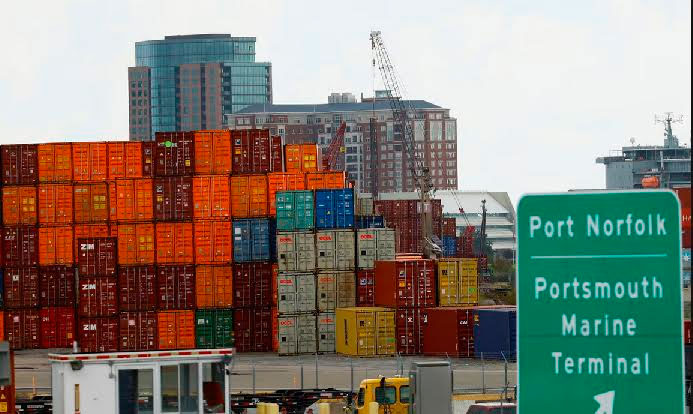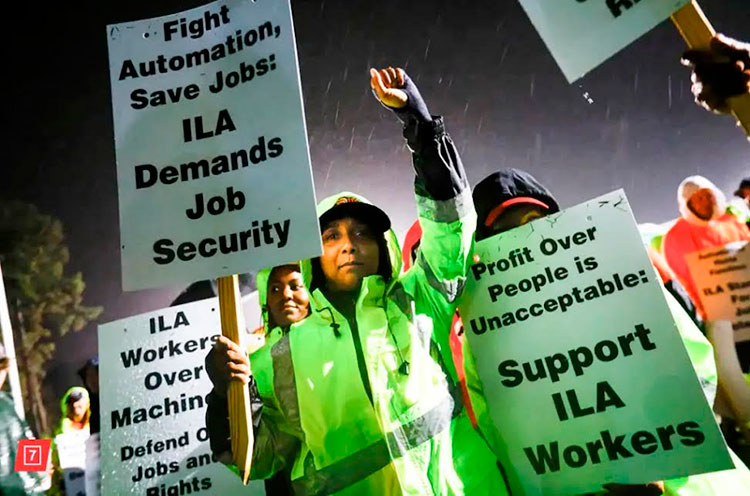In a few weeks, U.S. markets could run out of bananas, cherries, pineapples, seafood, coffee, chocolate, automobiles, toys, medical supplies, and hundreds of other products that enter the country through East Coast ports.

The impact would also have been felt in other countries, especially those whose economies depend on exports to the largest market in America, which would be forced to find new trade routes with the expected increase in transportation costs.
These are some of the likely consequences of the International Longshoremen’s Association (ILA) strike that ended last Thursday after the United States Maritime Alliance, Ltd. (USMX) reached a tentative agreement to improve wages.
The union assured that it has also been agreed to extend the term of the current master contract until January 15, 2025, by which time a new one will have to be ready.
The ILA unites more than 45,000 longshore workers on the U.S. East and Gulf coasts from Maine to Texas. This is the first strike since 1977.
What do they claim?
In negotiations withemployers, the longshoremen are demanding wage increases of $5 an hour each year over a six-year contract, as well as improved benefits and job protections in light of USMX’s announcement that it will increase automation in the production process, eliminating thousands of jobs, which the union strongly opposes.
The strike was timely. On the one hand, it coincided with the expiration date of the contract negotiated years ago between the ILA and the agency representing the ports and carriers. On the other hand, the proximity of the busy holiday shopping season added pressure on the USMX, which was under pressure to end the protest.

The ILA has denounced that employers «do not adequately compensate dockworkers. They cite the example of Maersk, one of the largest shipping companies, which «has made more than $50 billion in profits over the past four years.
«Carriers are gouging their customers, which is resulting in higher costs for U.S. consumers. They are now charging $30,000 for a full container. That’s a whopping $6,000 increase per container in just a few weeks. Meanwhile, dedicated ILA dockworkers continue to be hurt by inflation due to unfair USMX wage packages,» the union said in a September 30 press release.
According to analysts, the sector’s profits will exceed $400 billion between 2020 and 2023 as shipping rates soar during and after the pandemic. Such a figure could surpass all the profits made by container shipping before that date, estimated John McCown, a U.S. transportation and logistics expert quoted by CNN.
A Privileged Sector?
The threat of shortages in the land of full shelves raised the voices of more than one » class colleague » who considers dockworkers to be a privileged sector among U.S. workers because they generally receive higher wages than other occupations, with overtime pay and special conditions.


They have health care coverage that includes medical, dental and vision care; access to pension plans and retirement savings; and union membership provides opportunities for training, protection from unfair layoffs and representation to collectively bargain for job improvements.
These conditions explain the high employment stability in the sector, despite the risks and demanding working conditions.
ILA President Harold Dagget has said that his members’ demands are «more than fair» because «the highest paid work up to 100 hours a week, mostly overtime, sacrificing much of their family time.

The maximum hourly wage for most of these workers is $39, which translates into an average annual gross income of about $81,000. But those with less than six years on the job earn half that. «In cities like New York, where inflation has caused rents and other expenses to skyrocket, these are barely living wages,» the union leader argued.
A Friend of Workers?
President Joe Biden praised the agreement «for acting patriotically to reopen our ports and ensure the availability of critical supplies for Hurricane Helene recovery and rebuilding. He also commented that collective bargaining is «critical to building a stronger economy from the middle class out and from the bottom up.
But unionists are well aware of the latent threat behind the words of «labor’s best friend»: the anti-union Taft-Hartley Act.
Also known as the National Labor Relations Act, it was passed in 1947 to curb the growing power of unions after World War II. The controversial act restricted union practices and gave employers and the government more power to regulate union activity. It allowed strikes to be called off on the grounds that they «endangered national health and safety» and banned solidarity boycotts. It also requires union leaders to sign affidavits stating that they do not support communist organizations.
The law has been used 37 times, most recently in November 2022, when Biden, after a meeting with congressional leaders of both parties, announced an obligation to end the railroad strike and imposed a «tentative agreement» that had already been rejected by four of the 12 unions in the sector.

Now, the U.S. Chamber of Commerce, journalists from media outlets such as the Wall Street Journal, and some Republican senators have proposed reusing the repressive code, with the chilling effect that implies.
It took only two days, however, for a truce to be reached, with half of the benefits going to both sides. Perhaps the proximity of the closest presidential election in U.S. history persuaded the parties not to add fuel to the fire.
Time for Union Struggles
The article Solidarity with striking dockworkers, published on the Panorama-Mundial website, notes that «the dockworkers’ strike is part of a growing list of encouraging signs for the U.S. working class: an upsurge in union struggles that have won some important victories after decades of setbacks and defeats. These include efforts led by young workers to unionize employers like Amazon and Starbucks, as well as the successful contract fight by the Teamsters at UPS in 2023.»

The most recent major victory for the working class was the nationwide strike a year ago by the United Auto Workers (UAW) against the Big Three automakers. Following that victory, the UAW expanded its organizing efforts in non-union plants, especially in the South.
In the Seattle area, some 33,000 members of District 751 of the International Association of Machinists (IAM) began a strike against aerospace giant Boeing on September 13. This strike, now in its fourth week, is another indication that more workers are realizing the leverage they have and are using it properly to reverse some of the countless concessions employers have forced on them over the past half century.
With similar goals in mind, another 5,000 IAM members went on strike on September 23 at Textron Aviation in Wichita, Kansas. The workers, who make Beechcraft and Cessna aircraft at the plant, are demanding better wages and benefits.


